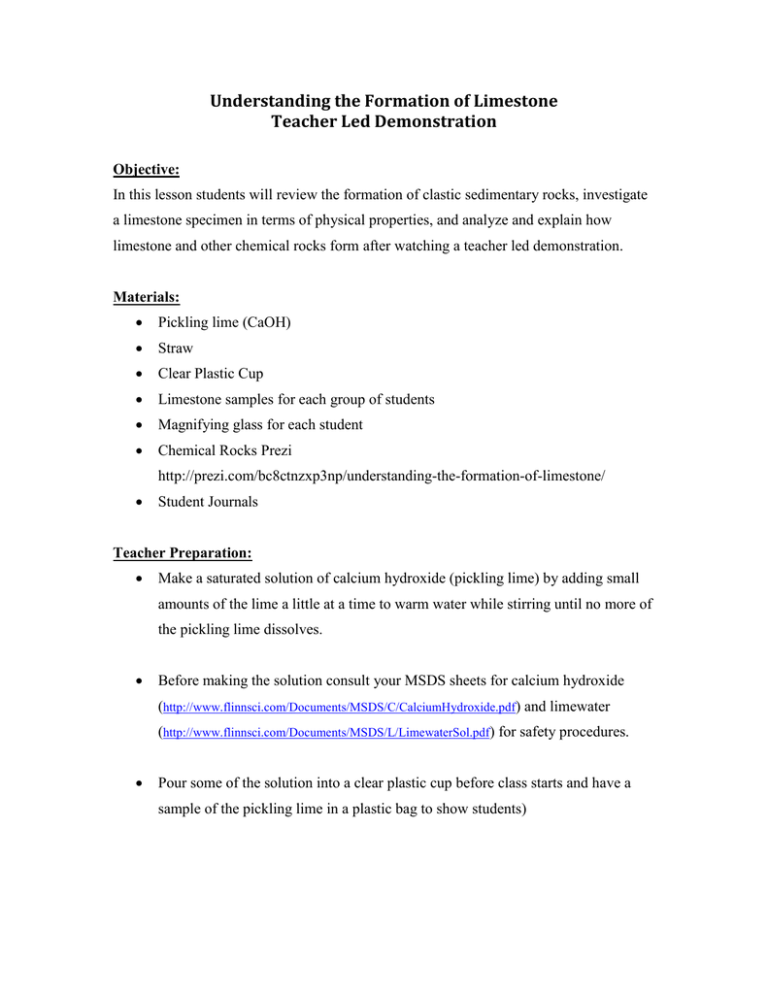Understanding the Formation of Limestone Teacher Led Demonstration
advertisement

Understanding the Formation of Limestone Teacher Led Demonstration Objective: In this lesson students will review the formation of clastic sedimentary rocks, investigate a limestone specimen in terms of physical properties, and analyze and explain how limestone and other chemical rocks form after watching a teacher led demonstration. Materials: Pickling lime (CaOH) Straw Clear Plastic Cup Limestone samples for each group of students Magnifying glass for each student Chemical Rocks Prezi http://prezi.com/bc8ctnzxp3np/understanding-the-formation-of-limestone/ Student Journals Teacher Preparation: Make a saturated solution of calcium hydroxide (pickling lime) by adding small amounts of the lime a little at a time to warm water while stirring until no more of the pickling lime dissolves. Before making the solution consult your MSDS sheets for calcium hydroxide (http://www.flinnsci.com/Documents/MSDS/C/CalciumHydroxide.pdf) and limewater (http://www.flinnsci.com/Documents/MSDS/L/LimewaterSol.pdf) for safety procedures. Pour some of the solution into a clear plastic cup before class starts and have a sample of the pickling lime in a plastic bag to show students) Lesson: (A PowerPoint presentation of the lesson has been provided for you to use with the students if you would like) Engage: Tell students that today they will be working with limestone, examining specimens of the rock, and investigating how it is formed. Before beginning the actual lesson have students review what they already know about sedimentary rocks by complete a circle map in their science journals. After giving students a few minutes facilitate a discussion on their prior knowledge of sedimentary rocks. If students do not bring up what sedimentary rocks are formed from (sediments) and how sedimentary rocks are formed be sure to bring up these topics. Make sure students understand that the sediments found in sedimentary rock can be bits of rocks, shells, or the remains of once living plants and animals. Remind students that clastic sedimentary rocks are rocks that are made of broken pieces of other rocks and these pieces often look like mud, sand, and gravel when we examine these rock specimens. Tell them that today, however, they are not going to be looking at sedimentary rocks that are made of smaller rocks, but instead are going to examine some sedimentary rocks that are made when dissolved materials precipitate from a solution. These rocks are called chemical rocks and are classified by their mineral content. They also contain materials produced by living organisms. Explore: Provide each group with a sample of limestone and have them examine it with hand lenses to see if they can see individual particles or fossils in the sample. After students have had time to examine and discuss the limestone sample, explain that the most common type of limestone is formed from the remains of ocean organisms like clams, snails, corals, and foraminifera (tiny once-celled organisms that float in the upper part of the oceans.) Show students photographs of coral reefs and foraminifera. Explain to students that the shells of snails, clams, and foraminifera and the skeletons of coral are created from calcite found in the ocean water. When these organisms die their shells and skeletons are left behind as sediments. Explain: Model for students how calcite can be precipitated by blowing through the straw into the plastic cup of limewater. Explain to students that dissolving lime in warm water created the limewater. Show students the lime, but do not pass it around. Tell students that in this model the lime represents limestone rocks that are dissolved by rivers and streams. Limestone rock is made of the mineral calcite and the dissolved calcite is dissolved into ocean waters by the rivers and streams. Let students know that the carbon dioxide from your breath represents the carbon dioxide from the air, which reacts with the lime dissolved in the water to create white solid flakes of calcite. Be sure to wear goggle and gloves while conducting the demo and keep the solution at a safe distance from students. Have students watch for the flakes of calcite to form as you blow through the straw. Remind students that marine organisms like clam, snails, coral, and foraminifera precipitate calcite out of the ocean water to make their shells and skeletons. Ask them based on the demonstration what they think happens next to create limestone rock. Guide students to understand that after these organisms die their shells and skeletons sink to the bottom of the ocean floor and get buried by other sediments. The organisms then lithify (become rock) through cementation and compaction. Elaborate: Show students photographs of other chemical rocks (chert, dolomite, oolite, rock salt, iron ore, and coquina) and discuss the formation of each of them. Evaluate: Have students create a flow map in their science journals that explains how chemical rocks are formed. You may have students complete this on their own, give them steps to put in order, or complete the flow map whole group. The steps of chemical rock formation are: weathering (dissolving) or pre-existing rock (limestone) by watererosion (movement) of dissolved rock by rivers and streams to the ocean precipitation of dissolved rock as sheels and skeletons by marine organisms deposition of shell and skeletal material and lithification (compaction and cementation) into rock Students can also compare and contrast clastic rock formation and chemical rock formation. (Both are weathered, eroded, deposited, compacted, and cemented but chemical rocks contain organic material and precipitate dissolved rock). Extend: Students can research foraminifera and coral reef environments and relate these findings to the formation of limestone rock layers. References: This lesson is adapted from a sixth grade lesson on Sedimentary Rocks created by the Pennsylvania Department of Education Standards Aligned System and can be found at http://www.pdesas.org/module/content/resources/13984/view.ashx



